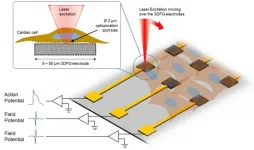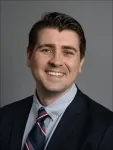(Press-News.org) A new study finds that brachytherapy, a common procedure that delivers radiation directly to cancer cells, may continue safely, potentially without delay or antibiotics, in cervical cancer patients following uterine perforation.
According to the World Health Organization, cervical cancer is the fourth most common cancer in women. Treatment for cervical cancer often involves brachytherapy combined with daily radiation therapy. Brachytherapy delivers radiation directly to cancer cells through a tube placed within the uterus.
"At times this tube can pierce the uterus and lead to a perforation," said William Small, Jr., MD, lead study author and professor and chair of radiation oncology at Loyola Medicine and Loyola University Chicago Stritch School of Medicine. "Many clinicians will not proceed with the treatment when a perforation occurs. This can lead to delays in therapy that may increase the recurrence risk and potentially lead to worse survival rates."
In the new study, "Uterine perforation during brachytherapy for cervical cancer: Complications, outcomes, and best practices for forward treatment planning and management," researchers sought to determine the incidence of uterine perforations, review associated complications, and propose guidelines for the management of perforations after brachytherapy.
Researchers conducted a retrospective review of 123 patients with cervical cancer who received single or multiple high-dose therapy implants between April 2006 and May 2017 at Loyola University Medical Center. Patient CT and MRI images were reviewed to identify uterine perforation caused by the tandem, the tube placed within the uterus to deliver radiation. Acute and long-term complications during and after treatment were scored using the National Cancer Institute's Common Terminology Criteria for Adverse Events Version 4.0.
Perforations were observed in 22 patients (17.9%) and 31 (6.4%) of the 482 total implants. Three patients developed acute infectious complications; two of these patients had mild urinary tract infections, which resolved without complications or treatment delays. The third patient had a complex perforation, received antibiotics and required a one-week treatment delay. Of the different categories of adverse events, only the rate of acute infectious complications among those with perforations (13.6%) versus those without perforations (3%) was significant.
"Our study notes that when perforation occurs, treatment can proceed without delay, potentially improving survival," said Dr. Small, who is also director of Loyola's Cardinal Bernardin Cancer Center. Treatment also may proceed without prophylactic antibiotics.
"If confirmed with additional data, the findings could lead to a new standard of care with the potential to save significant lives around the world," said Dr. Small.
The study first appeared online March 17, 2021 in the journal Brachytherapy.
INFORMATION:
About Stritch School of Medicine
Founded in 1909, Loyola University Chicago's Stritch School of Medicine is one of only four Catholic-affiliated medical schools in the nation. This fall, Stritch welcomed 170 students from 75 colleges to its 2024 class out of more than 14,000 applicants. With its academic medical center partner Loyola Medicine, Stritch clinical and basic science faculty help train the next generation of physicians and scientists. Learn more about Stritch, "like" us on facebook.com/StritchMedicine, or follow us on Twitter @LoyolaHSD.
About Loyola Medicine
Loyola Medicine, a member of Trinity Health, is a nationally ranked academic, quaternary care system based in Chicago's western suburbs. The three-hospital system includes Loyola University Medical Center, Gottlieb Memorial Hospital and MacNeal Hospital, as well as convenient locations offering primary care, specialty care and immediate care services from more than 1,800 physicians throughout Cook, Will and DuPage counties. Loyola is a 547-licensed-bed hospital in Maywood that includes the William G. & Mary A. Ryan Center for Heart & Vascular Medicine, the Cardinal Bernardin Cancer Center, a Level 1 trauma center, Illinois's largest burn center, a certified comprehensive stroke center and a children's hospital. Loyola also trains the next generation of caregivers through its academic affiliation with Loyola University Chicago's Stritch School of Medicine and the Marcella Niehoff School of Nursing. Gottlieb is a 247-licensed-bed community hospital in Melrose Park with the newly renovated Judd A. Weinberg Emergency Department, the Loyola Center for Metabolic Surgery and Bariatric Care and the Loyola Cancer Care & Research facility at the Marjorie G. Weinberg Cancer Center. MacNeal is a 374-licensed-bed teaching hospital in Berwyn with advanced medical, surgical and psychiatric services, acute rehabilitation, an inpatient skilled nursing facility and a 68-bed behavioral health program and community clinics. Loyola Medical Group, a team of primary and specialty care physicians, offers care at over 15 Chicago-area locations. For more information, visit loyolamedicine.org. You can also follow Loyola Medicine on LinkedIn, Facebook or Twitter.
About Trinity Health
Trinity Health is one of the largest multi-institutional Catholic health care delivery systems in the nation, serving diverse communities that include more than 30 million people across 22 states. Trinity Health includes 92 hospitals, as well as 100 continuing care locations that include PACE programs, senior living facilities, and home care and hospice services. Its continuing care programs provide nearly 2.5 million visits annually. Based in Livonia, Mich., and with annual operating revenues of $18.8 billion and assets of $30.5 billion, the organization returns $1.3 billion to its communities annually in the form of charity care and other community benefit programs. Trinity Health employs about 123,000 colleagues, including 6,800 employed physicians and clinicians. Committed to those who are poor and underserved in its communities, Trinity Health is known for its focus on the country's aging population. As a single, unified ministry, the organization is the innovator of Senior Emergency Departments, the largest not-for-profit provider of home health care services -- ranked by number of visits -- in the nation, as well as the nation's leading provider of PACE (Program of All Inclusive Care for the Elderly) based on the number of available programs. For more information, visit trinity-health.org. You can also follow Trinity Health on LinkedIn, Facebook or Twitter.
Lessons learned from the world's protected forests: Just declaring a plot of land protected isn't enough - conservation needs thoughtful selection and enforcement.
A group of scientists, many tied to Michigan State University, examined nearly 55,000 protected areas across the world to understand what it took to effectively protect their forests - a key benchmark to protecting habitat and preserving natural resources. They conclude that it's important to protect the forests exposed to the most threats in areas close to cities and be prepared to be strict in enforcing rules intended to stop deforestation.
In a recent issue of Science of the Total Environment, researchers noted that more than 4 million square kilometers ...
In the southern sky, situated about 4,300 light years from Earth, lies RCW 120, an enormous glowing cloud of gas and dust. This cloud, known as an emission nebula, is formed of ionized gases and emits light at various wavelengths. An international team led by West Virginia University researchers studied RCW 120 to analyze the effects of stellar feedback, the process by which stars inject energy back into their environment. Their observations showed that stellar winds cause the region to expand rapidly, which enabled them to constrain the age of the region. These findings indicate that RCW 120 must be less than 150,000 years old, which is very young for such ...
Behind every heartbeat and brain signal is a massive orchestra of electrical activity. While current electrophysiology observation techniques have been mostly limited to extracellular recordings, a forward-thinking group of researchers from Carnegie Mellon University and Istituto Italiano di Tecnologia has identified a flexible, low-cost, and biocompatible platform for enabling richer intracellular recordings.
The group's unique "across the ocean" partnership started two years ago at the Bioelectronics Winter School (BioEl) with libations and a bar napkin sketch. It has evolved into research published today in Science ...
Slow down. Baby on board.
So says UBC Okanagan researcher and Associate Professor of Mechanical Engineering Hadi Mohammadi. His new research, conducted in collaboration with Sharif University of Technology, determines that accelerating over speed bumps poses a danger for pregnant women and their fetuses.
"There is lots of research about the importance of movement for women during pregnancy," explains Mohammadi, who teaches in the School of Engineering. "Our latest research looked specifically at the impacts of sudden acceleration on a pregnant woman."
Using new modelling based on data from ...
When the Webster-Kirkwood Times, a community newspaper in the greater St. Louis, Missouri area, had to endure layoffs and stop publishing its print edition -- due to a loss in revenue as a result of the COVID-19 pandemic -- its readers felt the loss and began supporting the newspaper in earnest.
"A lot of times people don't know what they've got until it's gone," said Jaime Mowers, editor-in-chief of the Webster-Kirkwood Times. "Now, there is such a newfound appreciation for the newspaper. It's amazing to have the community's support, knowing we are loved that much and appreciated enough to ...
BUFFALO, N.Y. - Mindfulness is big business. Downloads of mindfulness apps generate billions of dollars annually in the U.S., and their popularity continues to rise. In addition to what individual practitioners might have on their phones, schools and prisons along with 1 in 5 employers currently offer some form of mindfulness training.
Mindfulness and meditation are associated with reducing stress and anxiety, while increasing emotional well-being. Plenty of scholarship supports these benefits. But how does mindfulness affect the range of human behaviors -- so-called prosocial behaviors -- that can potentially help or benefit other people? What happens when the research looks outwardly at social effects of mindfulness rather than inwardly at its personal effects?
It's ...
Human screams signal more than fear and are more acoustically diverse than previously thought, according to a study published April 13th 2021 in the open-access journal PLOS Biology by Sascha Fru?hholz of the University of Zurich, and colleagues. Remarkably, non-alarming screams are perceived and processed by the brain more efficiently than alarming screams.
In nonhuman primates and other mammalian species, scream-like calls are frequently used as an alarm signal exclusively in negative contexts, such social conflicts or the presence of predators or other environmental threats. Humans are also assumed to use screams to signal danger and to scare predators. But humans scream not only when they are ...
First study to examine suicides occurring around the world during the COVID-19 pandemic finds that - in high-income and upper-middle-income countries - suicide numbers have remained largely unchanged or have declined in the early months of the pandemic, compared with expected levels.
However, the authors stress that governments must remain vigilant as the longer-term mental health and economic effects of the pandemic unfold and be poised to respond if the situation changes.
Study looked at numbers of suicides in 21 countries between 1 April and 31 July 2020 and compared these with trends in the previous one to four years.
A new observational study ...
Screaming can save lives. Non-human primates and other mammalian species frequently use scream-like calls when embroiled in social conflicts or to signal the presence of predators and other threats. While humans also scream to signal danger or communicate aggression, they scream when experiencing strong emotions such as despair or joy as well. However, past studies on this topic have largely focused on alarming fear screams.
Humans respond to positive screams more quickly and with higher sensitivity
In a new study, a team at the University of Zurich Department of Psychology led by Sascha Frühholz ...
Living near a hazardous waste or Superfund site could cut your life short by about a year, reports Hanadi S. Rifai, John and Rebecca Moores Professor of Civil and Environmental Engineering at the University of Houston. The study, published in Nature Communications and based on evaluation of 65,226 census tracts from the 2018 Census, is the first nationwide review of all hazardous waste sites and not just the 1,300 sites on the national priority list managed by the federal government.
The analysis shows a decrease of more than two months in life expectancy for those living near a Superfund site. When coupled with high disadvantage of sociodemographic factors like age, sex, marital status and income, the decrease could be nearly 15 months, ...





